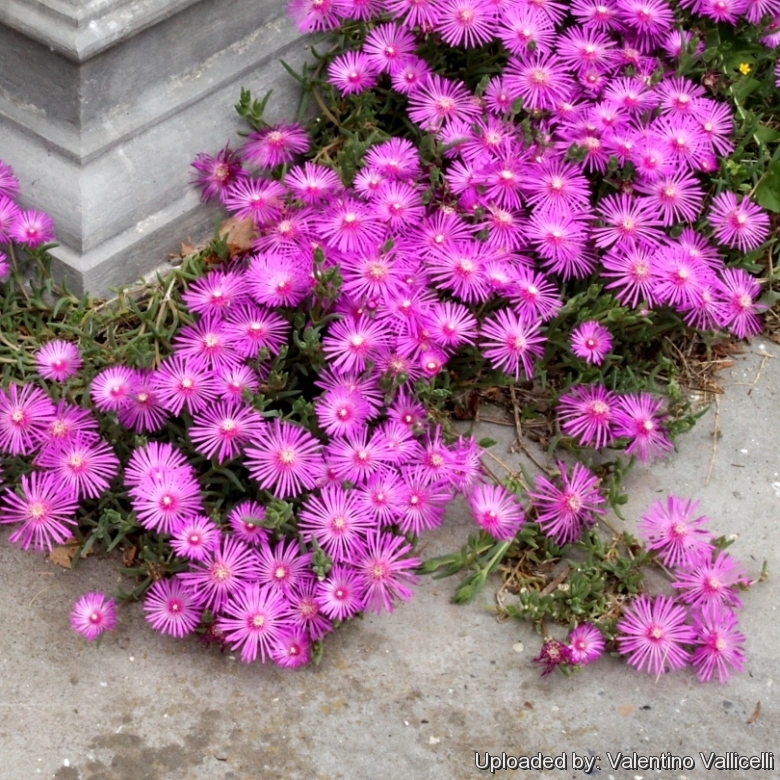Accepted Scientific Name: Delosperma cooperi (Hook.f.) L. Bolus
Fl. Pl. South Africa 7: t. 261 1927

Mesembryanthemum cooperi (Delosperma cooperi) Photo by: Valentino Vallicelli
Origin and Habitat: South Africa (Orange Free Stale. Transvaal).
Synonyms:
See all synonyms of Delosperma cooperi
back
Accepted name in llifle Database:Delosperma cooperi (Hook.f.) L. BolusFl. Pl. South Africa 7: t. 261 1927Synonymy: 3
back
Common Names include:
ENGLISH: Cooper's Ice Plant, Trailing Ice Plant, Hardy Ice Plant, Pink Carpet, Purple Hardy Ice Plant, Ice Plant
Description: Delosperma cooperiSN|21888]]SN|21888]] is the most widely available of the hardy ice plants that spreads rapidly forming a dense lawn of intermingled foliage, with fleshy leaves and a trailing stem that hangs down. The flowers are the most brilliant aspect of this plant, with the production of a great quantity of magenta or pink flowers that will often cover the entire site, hence the popular name "pink carpet". These abundant and long-lasting flowers will cover the plants during sunny hours and will remain in bloom from July through September.
Habit: It is a dwarf prostrate to decumbent perennial succulent plant reaching sizes of approximately 10-15 cm tall.
Stem: Trailing, ramified and spreading out. Hairless with internodes visible but usually shorter than the leaves.
Leaves: Opposed, sessile, long and narrow, more or less cylindrical somewhat tapering, shiny, medium green more or less glaucous, sometimes finely papillate, hairless, about 35-60 mm long and 6 mm wide with short shoots in their axils. In autumn, the fat leaves turn golden yellow and have a hint of pink at their tips.
Flowers: Solitary or in few-flowered cymes, aster-like 30-50 mm in diameter, pink, magenta or purple-red with a white centre .
Remarks: Delosperma cooperiSN|21888]]SN|21888]] is a highly hybridized plant. There are many colours and flower types.
Bibliography: Major references and further lectures
1) Heidrun E. K. Hartmann “Illustrated Handbook of Succulent Plants: Aizoaceae A-E” Springer, 2002
2) Gerrit, and Anita Fabian. “Transvaal Wild Flowers.” Johannesburg: Macmillan South Africa, 1982.
3) Stuart Max Walters “The European Garden Flora: Dicotyledons (Part I)” Cambridge University Press, 1989
4) Marie Harrison “Groundcovers for the South” Pineapple Press Inc, 2006
5) David Hardy, Anita Fabian, Gerrit Germishuizen “Succulents of the Transvaal” Southern Book Publishers, 1992
6) Hans Hecht “Cacti & Succulents” Sterling Publishing Company Incorporated, 1994
7) Debra Lee Baldwin “Designing with Succulents“ Timber Press, 18/mar/2011
8) Cythna Letty “Wild Flowers of the Transvaal” Editor: Wild Flowers of the Transvaal Book Fund, 1962
9) Larry Hodgson “Perennials for every purpose: choose the plants you need for your conditions, your garden, and your taste” Rodale, 01/feb/2000
10) Leistner, O. A. (ed.). “Seed plants of southern Africa: families and genera.” Strelitzia 10. National Botanical Institute, Pretoria. 2000
11) Smith, G. F.; Chesselet, P.; Van Jaarsveld, E. J.; Hartmann, H.; Hammer, S.; Van Wyk, B.-E.; Burgoyne, P.; Klak, C.; & Kurzweil, H. “Mesembs of the world.” Briza Publications, Pretoria. 1998
 Mesembryanthemum cooperi (Delosperma cooperi) Photo by: Valentino Vallicelli
Mesembryanthemum cooperi (Delosperma cooperi) Photo by: Valentino VallicelliSend a photo of this plant.The gallery now contains thousands of pictures, however it is possible to do even more. We are, of course, seeking photos of species not yet shown in the gallery but not only that, we are also looking for better pictures than those already present.
Read More... Cultivation and Propagation: The plants in this genus represent some of the more easily cultivated succulent species. In particular Delosperma cooperiSN|21888]]SN|21888]] has beautiful flowers, creating masses of colour in summer, along with interesting foliage, and adapts well to various soil types, and seems to be the only 'Ice plant' which is reasonably hardy and successful in temperate climates. It's tolerant of wet and cold and can tolerate less than perfect drainage, but it will suffer under prolonged water stagnation, and thus prefers well drained soils, or even rocky terrain.
Growth rate: It grows fast, needs to be contained or it becomes invasive, and also like to self seed everywhere. If not checked it could take over entire areas of garden, and even escape into the wild.
Soil: It prefers deep, well-drained, lean, sandy, or rocky soils.
Fertilization: Fertilize once early in the growing season with a light sprinkling of all-purpose fertilizer.
Watering: Water moderately from early spring to the end of autumn, and keep the compost quite dry when the plants are dormant watering, only if the plant starts shrivelling (, but they will generally grow even in winter if given water). Disliking overly wet conditions, it is best to also cover it with an anchored sheet of plastic during the winter if climate is particularly wet and cold. During wet seasons allow air circulation.
Exposure: Provide maximum light all the year round.
Hardiness: It is tolerant of both heat and cold and is hardy from zones (5-)6 through 10(-11). In areas prone to very intense frosts, grow in an intermediate greenhouse or conservatory, in pots of cactus compost, obtainable from good garden centres.
Salt tolerance: High
Uses: It is an easy-to-grow groundcover, ideal for low-maintenance and water-wise gardens, dry rocky free-draining ground and slopes where it is an ideal planting combination with other larger more architectural succulents like Aloe, Agave or Yucca. It is also perfect as a trailing plant hanging down a sunny wall or embankment or clambering over a rockery. It is typically used by the seashore for erosion control. Since it is fire resistant, it may be a good plant for drought-prone areas where fires are frequent. For groundcover effect, place plants about 30 cm apart. Delosperma nubigenurn (orange-yellow hardy ice plant ) is similar in appearance but is more hardy than Delosperma cooperiSN|21888]]SN|21888]]. One relative (Carpobrotus edulisSN|28886]]SN|28886]]) is an exotic invasive plant that is banned in some states. Butterflies are attracted to the blossoms.
Propagation: Cuttings. It is easily started by cuttings. Individual pieces of plants sprinkled on a prepared surface will root in a matter a few days.












